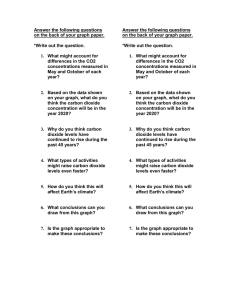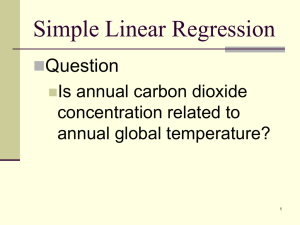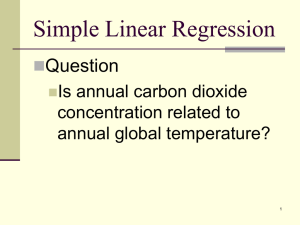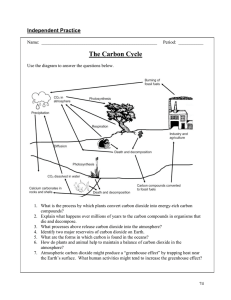On the water promoted reaction of titanium isopropoxide with carbon dioxide†
advertisement
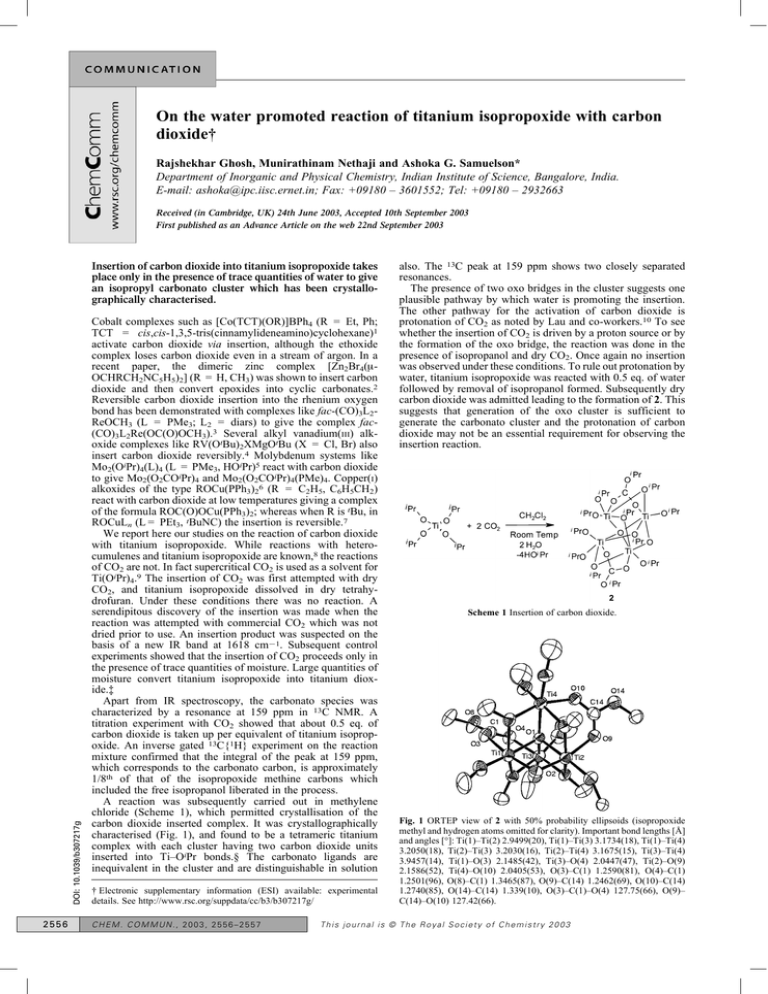
On the water promoted reaction of titanium isopropoxide with carbon
dioxide†
Rajshekhar Ghosh, Munirathinam Nethaji and Ashoka G. Samuelson*
Department of Inorganic and Physical Chemistry, Indian Institute of Science, Bangalore, India.
E-mail: ashoka@ipc.iisc.ernet.in; Fax: +09180 – 3601552; Tel: +09180 – 2932663
Received (in Cambridge, UK) 24th June 2003, Accepted 10th September 2003
First published as an Advance Article on the web 22nd September 2003
DOI: 10.1039/b307217g
Insertion of carbon dioxide into titanium isopropoxide takes
place only in the presence of trace quantities of water to give
an isopropyl carbonato cluster which has been crystallographically characterised.
2556
Cobalt complexes such as [Co(TCT)(OR)]BPh4 (R = Et, Ph;
TCT = cis,cis-1,3,5-tris(cinnamylideneamino)cyclohexane)1
activate carbon dioxide via insertion, although the ethoxide
complex loses carbon dioxide even in a stream of argon. In a
recent paper, the dimeric zinc complex [Zn2Br4(mOCHRCH2NC5H5)2] (R = H, CH3) was shown to insert carbon
dioxide and then convert epoxides into cyclic carbonates.2
Reversible carbon dioxide insertion into the rhenium oxygen
bond has been demonstrated with complexes like fac-(CO)3L2ReOCH3 (L = PMe3; L2 = diars) to give the complex fac(CO)3L2Re(OC(O)OCH3).3 Several alkyl vanadium(III) alkoxide complexes like RV(OtBu)2XMgOtBu (X = Cl, Br) also
insert carbon dioxide reversibly.4 Molybdenum systems like
Mo2(OiPr)4(L)4 (L = PMe3, HOiPr)5 react with carbon dioxide
to give Mo2(O2COiPr)4 and Mo2(O2COiPr)4(PMe)4. Copper(I)
alkoxides of the type ROCu(PPh3)26 (R = C2H5, C6H5CH2)
react with carbon dioxide at low temperatures giving a complex
of the formula ROC(O)OCu(PPh3)2; whereas when R is tBu, in
ROCuLn (L = PEt3, tBuNC) the insertion is reversible.7
We report here our studies on the reaction of carbon dioxide
with titanium isopropoxide. While reactions with heterocumulenes and titanium isopropoxide are known,8 the reactions
of CO2 are not. In fact supercritical CO2 is used as a solvent for
Ti(OiPr)4.9 The insertion of CO2 was first attempted with dry
CO2, and titanium isopropoxide dissolved in dry tetrahydrofuran. Under these conditions there was no reaction. A
serendipitous discovery of the insertion was made when the
reaction was attempted with commercial CO2 which was not
dried prior to use. An insertion product was suspected on the
basis of a new IR band at 1618 cm21. Subsequent control
experiments showed that the insertion of CO2 proceeds only in
the presence of trace quantities of moisture. Large quantities of
moisture convert titanium isopropoxide into titanium dioxide.‡
Apart from IR spectroscopy, the carbonato species was
characterized by a resonance at 159 ppm in 13C NMR. A
titration experiment with CO2 showed that about 0.5 eq. of
carbon dioxide is taken up per equivalent of titanium isopropoxide. An inverse gated 13C{1H} experiment on the reaction
mixture confirmed that the integral of the peak at 159 ppm,
which corresponds to the carbonato carbon, is approximately
1/8th of that of the isopropoxide methine carbons which
included the free isopropanol liberated in the process.
A reaction was subsequently carried out in methylene
chloride (Scheme 1), which permitted crystallisation of the
carbon dioxide inserted complex. It was crystallographically
characterised (Fig. 1), and found to be a tetrameric titanium
complex with each cluster having two carbon dioxide units
inserted into Ti–OiPr bonds.§ The carbonato ligands are
inequivalent in the cluster and are distinguishable in solution
† Electronic supplementary information (ESI) available: experimental
details. See http://www.rsc.org/suppdata/cc/b3/b307217g/
CHEM. COMMUN., 2003, 2556–2557
also. The 13C peak at 159 ppm shows two closely separated
resonances.
The presence of two oxo bridges in the cluster suggests one
plausible pathway by which water is promoting the insertion.
The other pathway for the activation of carbon dioxide is
protonation of CO2 as noted by Lau and co-workers.10 To see
whether the insertion of CO2 is driven by a proton source or by
the formation of the oxo bridge, the reaction was done in the
presence of isopropanol and dry CO2. Once again no insertion
was observed under these conditions. To rule out protonation by
water, titanium isopropoxide was reacted with 0.5 eq. of water
followed by removal of isopropanol formed. Subsequently dry
carbon dioxide was admitted leading to the formation of 2. This
suggests that generation of the oxo cluster is sufficient to
generate the carbonato cluster and the protonation of carbon
dioxide may not be an essential requirement for observing the
insertion reaction.
Scheme 1 Insertion of carbon dioxide.
Fig. 1 ORTEP view of 2 with 50% probability ellipsoids (isopropoxide
methyl and hydrogen atoms omitted for clarity). Important bond lengths [Å]
and angles [°]: Ti(1)–Ti(2) 2.9499(20), Ti(1)–Ti(3) 3.1734(18), Ti(1)–Ti(4)
3.2050(18), Ti(2)–Ti(3) 3.2030(16), Ti(2)–Ti(4) 3.1675(15), Ti(3)–Ti(4)
3.9457(14), Ti(1)–O(3) 2.1485(42), Ti(3)–O(4) 2.0447(47), Ti(2)–O(9)
2.1586(52), Ti(4)–O(10) 2.0405(53), O(3)–C(1) 1.2590(81), O(4)–C(1)
1.2501(96), O(8)–C(1) 1.3465(87), O(9)–C(14) 1.2462(69), O(10)–C(14)
1.2740(85), O(14)–C(14) 1.339(10), O(3)–C(1)–O(4) 127.75(66), O(9)–
C(14)–O(10) 127.42(66).
This journal is © The Royal Society of Chemistry 2003
Controlled hydrolysis of titanium compounds is known to
produce a wide range of Ti–O clusters.11–14 Clusters with
alkoxides containing the Ti4 core with oxo bridges range from
the Ti4(m3-O)n (n = 1 –2)11,12 to Ti4(m2-O)413 cluster. One of
these clusters also has a combination of both m3-O and m2-O.14
Clusters containing the Ti4(m4-O) core are not very common and
an example of a structure having this type of a core is found in
the reaction of titanium isopropoxide and formic acid.15
The isopropyl carbonate cluster 2, decomposed on deliberate
addition of 1 eq. of water per cluster (trace 3 in Fig. 2). Trace 2
in Fig. 2. shows partial removal of the inserted carbonato band
on addition of 1/2 an equivalent of water per cluster. A plausible
product 3 is given in Scheme 2. The carbonate formed on
hydrolysis is unstable but can be detected spectroscopically in
the distillate after addition of water (IR band at 1643 cm21).
Cluster 3 decomposes to give cluster 1 and titanium dioxide.
The former again undergoes insertion with CO2 (trace 5 in Fig.
2). This process can be repeated and the carbonato band
Fig. 2 Following the CO2 insertion with IR spectroscopy: 1, after 1st
insertion of CO2; 2 and 3, sequential addition of 1/4th eq. of H2O and
evacuation; 4, 1st re-insertion of CO2; 5, after repetition of steps 2, 3 and
4.
Scheme 2 Mechanism of reaction with carbon dioxide.
obtained repeatedly, albeit with reduction in the intensity of the
carbonato band.
Based on these observations, we conclude that the CO2
insertion product can be isolated only in the presence of an oxo
cluster. The isopropyl carbonato ligand, just like the formato
ligand15 can be stabilized only by bridging two titanium atoms
in the m4-O cluster. This is probably due to the large O–C–O
angle of about 127°. Even if titanium isopropoxide were to
insert carbon dioxide, the product would not be stable in the
absence of the oxo bridge and would decompose to release CO2
readily. Thus water is essential for promoting this reaction. We
gratefully acknowledge financial support of DST, New Delhi.
Notes and references
‡ Insertion of carbon dioxide: Titanium isopropoxide (1 ml 3.38 mmol) is
added to 30 ml of methylene chloride in a three necked flask under nitrogen.
Commercial grade carbon dioxide is passed for about 4 hours. The solvent
evaporates to about 3–4 ml during this process. 1H NMR (200 MHz) d 4.42
(sept), 4.73 (br), 4.64 (sept), 4.82 (sept), 4.89 (br), 4.99 (sept), 1.35 (d), 1.29
(d), 1.17 (d), 1.18 (d). 13C NMR (100M Hz) d 158.00, 157.78, 78.21, 76.87,
76.71, 75.89, 75.32, 69.55, 68.17, 67.62, 66.84, 62.71, 25.60, 24.84, 24.43,
23.58, 23.28, 21.41. IR cm21 solution 2963 (s), 2922 (s), 2868 (m), 1618 (s),
1579 (m), 1382 (s), 1314 (s), 1123 (vs), 1004 (vs), 947 (s), 852 (m), 810 (w),
617 (s). When this reaction mixture is allowed to stand at 220 °C for about
4–5 days small plate like crystals are formed which are very sensitive to air
and moisture but could be crystallographically characterized.
§ Compound 2. Empirical formula = C38H84O18Ti4, Crystal system =
Triclinic, Space group = P1̄, a = 11.843(2), b = 12.358(3), c = 20.466(4)
Å, a = 85.668(4), b = 81.109(4), g = 67.083(4), V = 2725.3(10) Å3, Z =
2, R1 = 0.0836, wR2 = 0.2291, R indices (all data) R1 = 0.1538, wR2 =
0.2674. CCDC 212131. See http://www.rsc.org/suppdata/cc/b3/b307217g/
for crystallographic data in .cif or other electronic format.
1 S. J. Archibald, S. P. Foxon, J. D. Freeman, J. E. Hobson, R. N. Perutz
and P. H. Walton, J. Chem. Soc., Dalton Trans., 2002, 2797.
2 H. S. Kim, J. J. Kim, B. G. Lee, O. S. Jung, H. G. Jang and S. O. Kang,
Angew. Chem. Int. Ed., 2000, 39, 4096.
3 R. D. Simpson and R. G. Bergman, Organometallics, 1992, 11, 4306.
4 G. A. Razuvaev, L. I. Vyshinskaya, V. V. Drobotenko, G. Ya. Mal’kova
and N. N. Vyshinskii, J. Organomet. Chem., 1982, 239, 335.
5 M. H. Chisholm, K. Folting, J. C. Huffman and R. J. Tatz, J. Am. Chem.
Soc., 1984, 106, 1153.
6 T. Yamamoto, M. Kubota and A. Yamamoto, Bull. Chem. Soc. Jpn.,
1980, 53, 680.
7 T. Tsuda, Y. Chuja and T. Saegusa, J. Am. Chem. Soc., 1980, 102,
431.
8 O. Meth-Cohn, D. Thorpe and H. J. Twitchett, J. Chem. Soc. (C), 1970,
132.
9 N. Tsutomu, Kobunshi Ronbunshu, 2001, 58, 710.
10 C. Yin, Z. Xu, Sheng-Y. Yang, S. M. Ng, K. Y. Wong, Z. Lin and C. P.
Lau, Organometallics, 2001, 20, 1216.
11 N. W. Eilerts, J. A. Heppert, M. L. Kennedy and F. Takusagawa, Inorg.
Chem., 1994, 33, 4813; P. D. Moran, C. E. F. Rickard, G. A. Bowmaker,
R. P. Cooney, J. R. Bartlett and J. L. Woolfrey, Inorg. Chem., 1998, 37,
1417.
12 G. Guerrero, M. Mehring, P. H. Mutin, F. Dahan and A. Vioux, J. Chem.
Soc., Dalton Trans., 1999, 1537; X. Lei, M. Shang and T. P. Fehlner,
Organometallics, 1996, 15, 3779; H. Shimomura, X. Lei, M. Shang and
T. P. Fehlner, Organometallics, 1997, 16, 5302.
13 G. M. H. Van de Velde, S. Harkema and P. J. Gellings, Inorg. Chim.
Acta, 1974, 11, 243; S. I. Troyanov and O. Y. Gorbenko, Polyhedron,
1997, 16, 777.
14 B. F. G. Johnson, M. C. Klunduk, T. J. O’Connell, C. McIntosh and J.
Ridland, J. Chem. Soc., Dalton Trans., 2001, 1553.
15 T. J. Boyle, T. M. Alam, C. J. Tafoya and B. L. Scott, Inorg. Chem.,
1998, 37, 558.
CHEM. COMMUN., 2003, 2556–2557
2557
